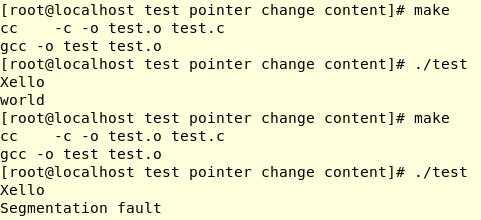标签:
C++/C程序中,指针和数组在不少地方可以相互替换着用,让人产生一种错觉,以为两者是等价的。数组要么在静态存储区被创建(如全局数组),要么在栈上被创建。数组名对应着(而不是指向)一块内存,其地址与容量在生命期内保持不变,只有数组的内容可以改变。指针可以随时指向任意类型的内存块,它的特征是“可变”,所以我们常用指针来操作动态内存。指针远比数组灵活,但也更危险。
示例代码,字符数组a的容量是6个字符,其内容为hello\0。a的内容可以改变,如a[0]= ‘X’。指针p指向常量字符串“world”(位于静态存储区,内容为world\0),常量字符串的内容是不可以被修改的。从语法上看,编译器并不觉得语句p[0]= ‘X’有什么不妥,但是该语句企图修改常量字符串的内容而导致运行错误。
1 #include <stdio.h> 2 3 int main(void) 4 { 5 char a[] = "hello"; 6 a[0] = ‘X‘; 7 printf("%s\n",a); 8 char *p = "world"; //this is constant that p point 9 //p[0] = ‘X‘; //can‘t change the const string the pointer ‘p‘ point . It appears "segmentation fault", when it is running. 10 printf("%s\n",p); 11 12 }
注释第九行和取消注释 运行结果如下所示

用运算符 sizeof 可以计算出数组的容量(字节数)。示例代码1中,sizeof(a)的值是 6(注意别忘了’\0’)。指针 p 指向 a,但是 sizeof(p)的值却是 4。这是因为sizeof(p)得到的是一个指针变量的字节数,相当于 sizeof(char*),而不是 p 所指的内存容量。C++/C 语言没有办法知道指针所指的内存容量,除非在申请内存时记住它。 注意当数组作为函数的参数进行传递时,该数组自动退化为同类型的指针。示例代码2中,不论数组 a 的容量是多少,sizeof(a)始终等于 sizeof(char *)。
代码1:
1 #include <stdio.h> 2 3 int main(void) 4 { 5 char a[] = "hello"; 6 a[0] = ‘X‘; 7 printf("%s\n",a); 8 printf("%d\n",sizeof(a)); 9 char *p = "world"; //this is constant that p point 10 //p[0] = ‘X‘; //can‘t change the const string the pointer ‘p‘ point . It appears "segmentation fault", when it is running. 11 printf("%s\n",p); 12 printf("%d\n",sizeof(p)); 13 14 }
结果如下: sizeof(a) 6 bytes, sizeof(p) 4 bytes

代码2:
1 #include <stdio.h> 2 3 void Func(char a[100]); 4 5 int main(void) 6 { 7 char a[] = "hello"; 8 Func(a); 9 10 } 11 12 void Func(char a[100]) 13 { 14 printf("Func %d\n",sizeof(a)); 15 }
结果如下 : Func 4 bytes 不是 100 bytes

标签:
原文地址:http://www.cnblogs.com/kylinjade/p/5027493.html